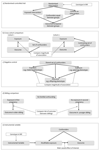Approaches for drawing causal inferences from epidemiological birth cohorts: a review
- PMID: 25260961
- PMCID: PMC5154380
- DOI: 10.1016/j.earlhumdev.2014.08.023
Approaches for drawing causal inferences from epidemiological birth cohorts: a review
Abstract
Large-scale population-based birth cohorts, which recruit women during pregnancy or at birth and follow up their offspring through infancy and into childhood and adolescence, provide the opportunity to monitor and model early life exposures in relation to developmental characteristics and later life outcomes. However, due to confounding and other limitations, identification of causal risk factors has proved challenging and published findings are often not reproducible. A suite of methods has been developed in recent years to minimise problems afflicting observational epidemiology, to strengthen causal inference and to provide greater insights into modifiable intra-uterine and early life risk factors. The aim of this review is to describe these causal inference methods and to suggest how they may be applied in the context of birth cohorts and extended along with the development of birth cohort consortia and expansion of "omic" technologies.
Keywords: Birth cohort; Causal inference; Consortia; DOHaD; Epidemiology; Epigenetics; Life course; Metabolomics; Omics.
Copyright © 2014 Elsevier Ltd. All rights reserved.
Conflict of interest statement
statement None declared.
Figures
References
-
- Gluckman P, Hanson Me. The developmental origins of health and disease. Cambridge: Cambridge University Press; 2006.
-
- Barker DJP. Mothers, babies and disease in later life. London: Churchill Livingstone; 1994.
Publication types
MeSH terms
Grants and funding
LinkOut - more resources
Full Text Sources
Other Literature Sources



